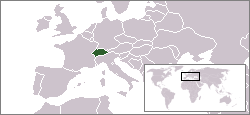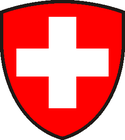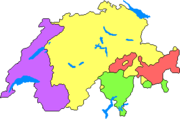Switzerland
|
|
The Swiss Confederation or Switzerland is a landlocked federal state in Europe, which borders Germany, France, Italy, Austria and Liechtenstein. The country has a strong tradition of political and military neutrality, but also of international co-operation, and is home to many international organisations.
Confederatio Helvetica (CH), the Latin version of the official name, avoids choosing one of the four official languages. The abbreviation is similarly used; for example, it is used as Switzerland's ccTLD, .ch.
| |||||
| Motto: Unus pro omnibus, omnes pro uno (English: One for all, all for one) | |||||
| Anthem: Swiss Psalm | |||||

| |||||
| Capital | Bern Template:Coor dm | ||||
| Largest city | Zurich | ||||
| Official languages | German, French, Italian, Romansh | ||||
| Government | Federal republic Moritz Leuenberger (VP 2005) Pascal Couchepin Joseph Deiss Samuel Schmid (Pres. 2005) Micheline Calmy-Rey Christoph Blocher Hans-Rudolf Merz | ||||
| Independence - Declared - Recognised Federal state | Federal Charter August 1, 1291 October 24, 1648 1848 | ||||
| Area • Total • Water (%) | 41,285 km² (132nd) 4.2 | ||||
| Population • 2003 est. • 2000 census • Density | 7,399,100 (92nd) 7,288,010 181/km² (44th) | ||||
| GDP (PPP) • Total • Per capita | 2003 estimate $233 billion (35th) $30,186 (8th) | ||||
| Currency | Swiss franc (CHF)
| ||||
| Time zone • Summer (DST) | CET (UTC+1) CEST (UTC+2) | ||||
| Internet TLD | .ch | ||||
| Calling code | +41
| ||||
| Contents |
History
Main article: History of Switzerland
Switzerland is a federation of relatively autonomous cantons, some of which have a history of confederacy that goes back more than 700 years, arguably putting them among the world's oldest surviving republics.
According to the popular legend, in 1291, representatives of the three forest cantons of Uri, Schwyz, and Unterwalden signed the Federal Charter. The charter united the involved parties in the struggle against foreign rule by the Habsburgs, who then held the German imperial throne of the Holy Roman Empire. At the Battle of Morgarten in 1315, the Swiss defeated the Habsburg army and secured quasi-independence as the Swiss Confederation. The authenticity of the Federal Charter is disputed with many historians agreeing that it is in fact a forgery of the 14th century.
By 1353, the three original cantons had been joined by the cantons of Glarus and Zug and the city states of Lucerne, [[Z?] and Berne, forming the "Old Federation" of eight states that persisted during much of the 15th century (although Z?was expelled from the confederation during the 1440s due to a territorial conflict) and led to a significant increase of power and wealth of the federation, in particular due to the victories over Charles the Bold of Burgundy during the 1470s, and the success of the Swiss mercenaries. The traditional listing order of the cantons of Switzerland reflects this state, listing the eight "Old Cantons" first, with the city states preceding the founding cantons, followed by cantons that joined the federation after 1481, in historical order. The Swiss victory in a war against the Swabian League in 1499 amounted to de facto independence from the Holy Roman Empire.
In 1506, pope Julius II engaged the Swiss Guard that continues to serve the Vatican to the present day. The expansion of the federation, and the reputation of invincibility acquired during the earlier wars, suffered a first setback in 1515 with the Swiss defeat in the Battle of Marignano.
The success of Zwingli's Reformation in some cantons led to inter-cantonal wars in 1529 and 1531 (Kappeler Kriege). The conflict between Catholic and Protestant cantons persisted, erupting in further violence at the battles of Villmergen in 1656 and 1712.
Stumpf-Chronik-Zug.png
Under the Treaty of Westphalia in 1648, European countries recognised Switzerland's independence from the Holy Roman Empire and its neutrality (ancien régime). In 1798, armies of the French Revolution conquered Switzerland and in 1803, Napoleon Bonaparte imposed a new constitution, largely restoring Swiss autonomy. The Congress of Vienna in 1815 fully re-established Swiss independence and the European powers agreed to permanently recognise the Swiss neutrality. At this time, the territory of Switzerland was increased for the last time, by the new cantons of Valais, Neuchatel and Geneva.
In 1847, a civil war broke out between the Catholic and the Protestant cantons (Sonderbundskrieg). Its immediate cause was a 'special treaty' (Sonderbund) of the Catholic cantons. The war lasted for less than a month, causing fewer than 100 casualties. Apart from small riots, this was the latest armed conflict on Swiss territory.
As a consequence of the civil war, Switzerland adopted a federal constitution in 1848, amending it extensively in 1874 and establishing federal responsibility for defence, trade, and legal matters. In 1891, the constitution was revised with unusually strong elements of direct democracy, which remain unique even today. Since then, continued political, economic, and social improvement has characterised Swiss history.
In 1920, Switzerland joined the League of Nations, and in 1963 the Council of Europe.
Switzerland proclaimed neutrality in World War I and was not involved militarily in the conflict. Neutrality was again proclaimed in World War II, and although a German intervention was both planned and anticipated, it ultimately didn't occur. The massive mobilization of Swiss armed forces under the leadership of General Henri Guisan is often cited as a decisive factor that the German invasion was never initiated. Modern historical findings, such as the research done by the Bergier commission, indicate that another major factor was the continued trade by Swiss banks with Nazi Germany.
Women were granted the right to vote in the first cantons in 1959, at the federal level in 1971, in the last canton only in 1990. In 1979, parts of the canton of Berne attained independence, forming the new canton of Jura. On April 18, 1999 the Swiss population and the cantons voted in favor of a completely revised federal constitution.
In 2002 Switzerland became a full member of the United Nations, leaving the Vatican as the last widely recognized state without full UN membership. Switzerland is not a member state of the EU but applied for membership therein in May 1992. Switzerland has not advanced this application since the rejection, by referendum, of the European Economic Area in December 1992. However, Swiss law is gradually being adjusted to that of the EU and the government has signed a number of bilateral agreements with the European Union. Switzerland (together with Liechtenstein) has been surrounded by the EU since Austria's membership in 1995. On June 5, 2005, Swiss voters agreed, by a 55% majority, to join the Schengen treaty, a result that was welcomed by EU commentators as a sign of goodwill by a Switzerland that is traditionally perceived as isolationist.
Politics
Main article: Politics of Switzerland
Curia_Confoederationis_Heleticae_-_Swiss_parliament_and_government.jpg
Switzerland features a system of government unlike any other seen in Europe, or indeed much of the world.
The bicameral Swiss parliament, the Federal Assembly, is the primary seat of power, apart from the Federal Council. Both houses, the Council of States and the National Council, have equal powers in all respects, including the right to introduce legislation.
Under the 1999 constitution, cantons hold all powers not specifically delegated to the federation.
The 46 members of the Council of States (two from each canton and one from former half cantons) are directly elected in each canton, whereas the 200 members of the National Council are elected directly under a system of proportional representation. Members of both houses serve for 4 years. Through referenda citizens may challenge any law voted by federal parliament and through initiatives introduce amendments to the federal constitution, making Switzerland a semi-direct democracy.
The top executive body and collective Head of State is the Federal Council, a collegial body of seven members. Although the constitution provides that the Assembly elects and supervises the members of the Council, the latter (and its administration) has gradually assumed a preeminent role in directing the legislative process as well as executing federal laws. The President of the Confederation is elected from the seven. During a one year term, she assumes special representative functions.
From 1959 to December 2003, the four major parties were represented in the Federal Council according to the "magic formula", proportional to their representation in federal parliament: 2 Christian Democrats (CVP/PDC), 2 from the Social Democrats (SPS/PSS), 2 Free Democrats (FDP/PRD), and 1 from the Swiss People's Party (SVP/UDC). This traditional distribution of seats, however, is not backed up by any law, and in the 2003 elections to the Federal Council the CVP/PDC lost their second seat to the SVP/UDC.
The function of the Federal Supreme Court is to hear appeals of cantonal courts or the administrative rulings of the federal administration. The judges are elected by the Federal Assembly for six-year terms.
See also:
Cantons (states)
Main article: Cantons of Switzerland
[[Image:Schweiz graubuenden sent.jpg|right|180px|thumb|Wintertime view of Sent, in the eastern canton of [[Graub?].]]
The Swiss Confederation consists of 26 cantons:
|
[*] these Cantons are represented by only one councilor in the Council of States.
The population varies between 15,000 (Appenzell Innerrhoden) and 1,253,500 (Z?, area between 37 km? (Basel-Stadt) and 7,105 km? (Grisons). Cantons are divided in a total of 2,889 municipalities.
The following are enclaves within Switzerland: B?n is territory of Germany, Campione d'Italia is territory of Italy.
Geography
Main article: Geography of Switzerland
Map-of-Switzerland.png
With an area of 41,000 square kilometers, Switzerland is a small country. The population is around 7.4 million, resulting in a population density of 184 people per km? (roughly comparable to the U. S. state of Maryland).
The Swiss landscape is characterised by the Alps, a high mountain range running across the central-south of the country. Amongst the high peaks of the Swiss Alps, the highest of which is the Dufour Peak at 4,634 m, are found countless valleys, some with glaciers. From these the headwaters of several major European rivers such as the Rhine, the [[Rhone River|Rh?], the Inn, the Aare or the Ticino, flow down into lakes such as Lake Geneva, [[Lake Z?], Lake Neuchⴥl, and Lake Constance and farther down.
Switzerland is made up of the Swiss Alps, Mittelland, and Jura.
The northern, more populous part of the country is more open, but can still be fairly mountainous such as with the Jura Mountains, a smaller range in the northwest. The Swiss climate is generally temperate, but it can vary greatly locally, from the harsh conditions on the high mountains to the pleasant Mediterranean climate at Switzerland's southern tip.
A zoomable map of Switzerland is available at either www.swissinfo-geo.org or www.swissgeo.ch, a zoomable satellite picture at map.search.ch.
See also: Swisstopo topographical survey, List of lakes of Switzerland, List of rivers of Switzerland, List of mountain passes in Switzerland.
Economy
Main article: Economy of Switzerland
Switzerland is a prosperous and stable modern market economy with a per capita GDP higher than that of the big western European economies. Switzerland is a member of the European Free Trade Association. The Swiss in recent years have brought their economic practices largely into conformity with the European Union's to enhance their international competitiveness. Full EU membership is a long-term objective of the Swiss government, but there is considerable popular sentiment against this. To this end, it has established an Integration Office (http://www.europa.admin.ch/e/index.htm) under the Department of Foreign and Economic Affairs. In order to minimise the negative consequences of Switzerland's isolation from the rest of Europe, Bern and Brussels signed seven agreements, called Bilateral Agreements I, to further liberalise trade ties in 1999 and entering into force in 2001. This first series of bilateral agreements included the free movement of persons. A second series covering nine areas was signed in 2004 and is waiting ratification. The second series includes the Schengen treaty and the Dublin Convention. They continue to discuss further areas for cooperation. Switzerland voted against membership in the European Economic Area in December 1992 and has since maintained and developed its relationships with the European Union and European countries via bilateral agreements.
Demographics
Main article: Demographics of Switzerland
Switzerland sits at the crossroads of several major European cultures, which have heavily influenced the country's languages and cultural practices. Switzerland has four official languages: German (64%; yellow) in the north and centre, French (19%; purple) to the west, Italian (8%; green) in the south, and finally Romansh, a Romance language spoken by a small minority (<1%; red) in the southeastern canton of [[Graub?] and parts of Ticino. There is no obligation for the state to translate its communication in all four languages, so most communication is in three languages and only some very important documents are translated to Romansh. Indeed, in the parliament, German, French and Italian are the official languages and simultaneous translation is provided. The German spoken in Switzerland is predominantly a group of dialects that are almost unintelligible to Germans and are collectively known as Swiss German, but newspapers and some broadcasts use High German, which is also the predominant language in the German part for any written communication. Swiss French and Swiss Italian differ far less from their counterparts spoken in France and Italy. Learning one of the other national languages is obligatory for all Swiss, so most Swiss speak two or more languages. Resident foreigners and temporary foreign workers make up about 20% of the population.
The largest religion in Switzerland is Roman Catholicism, to which some 43% of the population adhere. Various Protestant faiths number some 35% of the population, and immigration has established Islam (4%) and Eastern Orthodoxy (2%) as sizable minority religions. The remainder belongs to very small minorities or is unaffiliated. The stability and prosperity of Switzerland, combined with a linguistically and religiously diverse population has led some to describe the country as a consensus state or a consociational state.
Culture
Main article: Culture of Switzerland
The culture of Switzerland is influenced by its neighbours, but over the years a distinctive culture with strong regional differences has developed. Traditionally Switzerland is not considered one of the centres of European culture, but this conception might be deceptive.
A number of culturally active Swiss have chosen to move abroad, probably given the limited opportunities in their homeland. At the same time, the neutrality of Switzerland has attracted many creative people from all over the world. In war times the tradition of political asylum helped to attract artists, whilst recently low taxes seem predominant.
Strong regionalism in Switzerland makes it difficult to speak of a homogenous Swiss culture. The influence of German, French and Italian culture on their neighbouring parts and the influence of Anglo-American culture cannot be denied. The Rhaeto-Romanic culture in the eastern mountains of Switzerland is robust.
The Swiss are noted for their banks, their chocolate, their cheese, their pocket knives, their watches, their private boarding schools, and their strengths in engineering and the sciences.
The tallest building in Switzerland is the Basler Messeturm.
Maps of Switzerland
Pictures of Switzerland
Miscellaneous topics
- 2004 in Switzerland
- 2005 in Switzerland
- Communications in Switzerland
- Transportation in Switzerland
- Military of Switzerland
- Education in Switzerland
- Stamps and postal history of Switzerland
- Data codes for Switzerland
- List of cities in Switzerland
- List of Swiss people
- List of Switzerland-related topics
- Enlargement of the European Union
- Third country relationships with the EU
External links
- Governmental websites
- The Federal Authorities (http://www.admin.ch/ch/index.en.html)
- The Swiss Parliament (http://www.parlament.ch/e/homepage.htm)
- Federal Supreme Court (http://www.bger.ch) - (in German, French and Italian)
- Swiss Federal Statistical Office (http://www.bfs.admin.ch/bfs/portal/en/index.html)
- Switzerland's news and information platform (http://www.swissinfo.org/) - maintained by the public Swiss Broadcasting Corporation (in 9 languages)
- Swissworld (http://www.swissworld.org) - an encyclopedic presentation of the country by the Swiss Confederation
- About.ch (http://www.about.ch/) - another presentation of the country
- Historical Dictionary of Switzerland (http://www.dhs.ch/) - Country encyclopedia (in German, French and Italian)
- Culturelinks.ch (http://www.culturelinks.ch/) - a portal giving access to Swiss culture websites
- Switzerland Tourism (http://www.myswitzerland.com) National tourist office
- The Federal Constitution of the Swiss Confederation (http://www.admin.ch/ch/itl/rs/1/c101ENG.pdf)
- Spatial Planning in Switzerland (http://www.are.ch) Website of Swiss Federal Office for Spatial Development (land-use planning, transportation, sustainable development)
- Alemannic Wikipedia
| Countries in Europe |
|---|
| Albania | Andorra | Austria | Azerbaijan1 | Belarus | Belgium | Bosnia and Herzegovina | Bulgaria | Croatia | Cyprus2 | Czech Republic | Denmark | Estonia | Finland | France | Germany | Greece | Hungary | Iceland | Ireland | Italy | Latvia | Liechtenstein | Lithuania | Luxembourg | Macedonia | Malta | Moldova | Monaco | Netherlands | Norway | Poland | Portugal | Romania | Russia1 | San Marino | Serbia and Montenegro | Slovakia | Slovenia | Spain | Sweden | Switzerland | Turkey1 | Ukraine | United Kingdom | Vatican City |
| Dependencies: Akrotiri and Dhekelia2 | Faroe Islands | Gibraltar | Guernsey | Jan Mayen | Jersey | Isle of Man | Svalbard |
| 1. Country partly in Asia. 2. Usually assigned to Asia geographically, but often considered European for cultural and historical reasons. |



